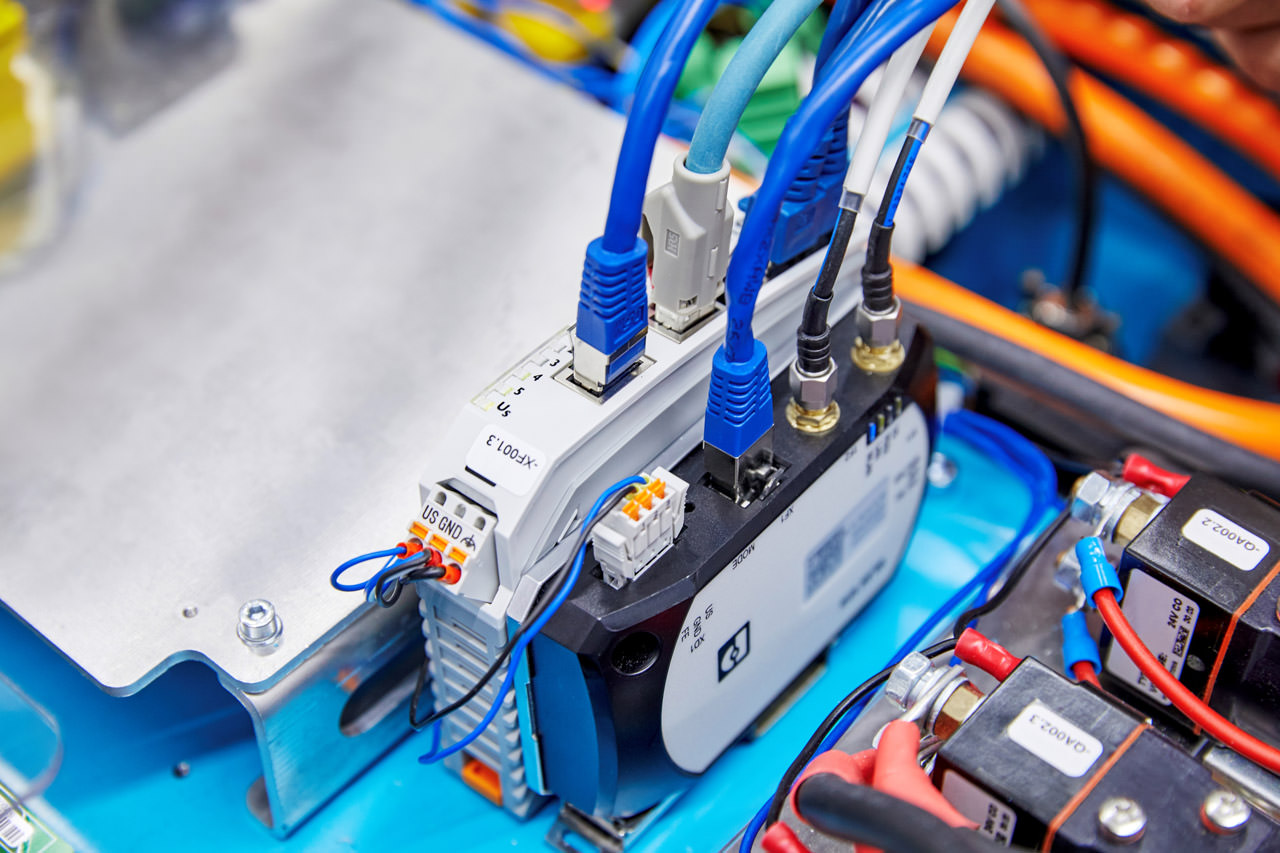TechnologyNovember 19, 2023
Wireless communication key to efficient, reliable production

The wireless exchange of data enables even the smallest devices in manufacturing systems to be easily integrated into the production network. The information from these coupled devices can then be used to improved the availability, performance and quality of the manufacturing process.
Current international developments coupled with the forecasts regarding climate change on Earth are forcing us to rethink how we handle the resources available on our planet. To this end, Phoenix Contact is aiming to meet precisely these challenges technologically with its vision of the future, the All Electric Society – among other things by optimizing the communication infrastructure in the manufacturing environment.
The All Electric Society
The All Electric Society is a world in which energy from renewable resources is available in sufficient quantities and at affordable prices. In addition to the consistent generation and use of renewable energy, the reduction of primary energy demands through energy efficiency measures is proving to be the key to a sustainable future. Companies in particular must support this development across all areas; otherwise they will be at a competitive disadvantage in the future. One particular focus in this context is on production, because this area accounts for a large proportion of a company’s energy consumption. It is therefore important to increase the efficiency of machines and systems.
At the same time, it is imperative that technical availability and flexibility in application is not overlooked to ensure that a rapid response to changing market and environmental conditions is possible. By inference, this requires new technological approaches which are already finding their way into manufacturing infrastructures through the realization of Industry 4.0. The basis for this is a powerful network infrastructure.
New automation approaches in the logistics sector
The term Industry 4.0 embodies the comprehensive digitalization and networking of automation devices both within a company’s in-house production facilities and across company boundaries.
Depending on the application, the components involved are networked using different technologies. Whereas wired solutions based on copper conductors or optical fibers were the mainstay in the past, wireless infrastructures such as WLAN, Bluetooth, and 5G are now increasingly being used in a variety of applications. The Internet of Things (IoT), which builds on this, aims to integrate even the smallest devices – such as sensors – into the network and to realize new automation approaches such as the use of automated guided vehicles (AGVs) within the logistics sector. The information and feasible solutions made available through this approach significantly improve the availability, performance, and quality of the manufacturing systems, while at the same time increasing flexibility.

Wireless communication infrastructures are increasingly finding their way into production systems to increase their efficiency and flexibility.
Wi-Fi 6 with up to 70 percent lower latency
Current industrial trends, such as IoT and artificial intelligence, are placing ever higher demands on the availability, latency, and data throughput of industrial communications.
To provide these systems with up-to-date production data, the data sources must be connected through high-performance systems. So far, these requirements have usually only been achieved through wired data transmission. However, further developments in the field of wireless LAN (WLAN) mean that the transmission of data via wires can be extended or replaced with WLAN solutions. The handling of those mobile machines and machine parts that are not always connected and are docked, for example, is simplified because cables are not having to be constantly plugged in and unplugged.
The new Wi-Fi 6 standard (WLAN 802.11ax) has increased the theoretical data transmission speed by around 30 percent. By enabling more data to be sent to multiple devices simultaneously, latency has also been reduced by up to 70 percent. This is made possible by a number of parallel data connections – an approach known as Multi-User MIMO (Multiple Input, Multiple Output). The extension of the Wi-Fi 6 standard to Wi-Fi 6(E) is proving compelling for applications in which different trades use WLAN.
Currently, this can lead to duplicate use of the channels, meaning that communication is impaired or even fails. The E extension to the Wi-Fi 6 specification means that the license-free 6 GHz frequency band is now available with 14 additional 80 MHz channels and seven additional 160 MHz channels. With this frequency band extension, additional WLAN networks can be installed alongside the existing ones without mutual interference.

Wi-Fi access point for mobile machine access for maintenance purposes, for forwarding alerts, and for monitoring.
Compact and robust wireless modules for AGVs and AMRs
The wireless transmission of data to superordinate fleet management systems plays an important role in automated guided vehicle (AGV) and autonomous mobile robot (AMR) systems in which the vehicles and robots are used as mobile units in manufacturing areas. It is difficult to use the AGVs/AMRs efficiently in a production scenario if the data connection to the vehicles and robots is not reliable. As a result, there are demanding and varying requirements on the wireless solutions installed in the AGVs/AMRs. These include the limited installation space in the vehicles, the quality of the wireless communication, the availability of the data connection over the operating time of the vehicles (QoS), the robustness of the systems located in the vehicles against vibrations and temperature influences, and finally their diagnostics and maintenance functions.
To realize such requirements, Phoenix Contact has developed the FL WLAN 1010 and FL WLAN 1100 wireless modules designed for Wi-Fi transmission in the field of AGVs/AMRs. The devices can be installed easily in the vehicles. With the integrated REST interface, for example, the individual system Wi-Fi settings can be automatically transferred to the FL WLAN 1010 or FL WLAN 1100 via the vehicle control system. This saves time and eliminates incorrect configurations during vehicle commissioning.
Careful planning of the wireless channel design
In addition to how the AGVs/AMRs are equipped, the WLAN building infrastructure is also crucially important. Several points must be considered when designing this infrastructure. The first is the correct placement of the access points within the building, which determines the wireless coverage. The wireless coverage within the various areas depends on how much metal is installed there in the form of machinery, equipment, and building structures, because this material can reflect the radio waves. However, simulation tools can help determine in advance the coverage and reflections.
The use of suitable antennas and their positioning must also be taken into account. WLAN transmission is a shared medium, and so it is important to make plans in advance regarding the use of the wireless channels and how they are distributed. Careful planning of the wireless channel design in relation to the respective applications can reveal potential problems in operation at an early stage. The design and planning of the WLAN infrastructure can prove to be complex and requires some experience. To this end, the specialists from Phoenix Contact provide users with support in designing the WLAN infrastructure.

The FL WLAN 1010 wireless module in the AGV, mounted directly on the vehicle chassis or a DIN rail, has two antenna inputs for improved wireless quality.
Summary
The wireless exchange of data enables even the smallest devices to be integrated into the production network. The information from the coupled devices improves the availability, performance, and quality of the manufacturing systems. The compact, robust, and easy-to-mount FL WLAN 1010 and FL WLAN 1100 wireless modules with special integrated antennas help ensure that AGVs and AMRs function reliably, among other things.

Holistic security concepts for comprehensive protection
Holistic security concepts for comprehensive protection
Recent events have illustrated how important it is to protect systems against unauthorized access by people or malware. Cyberattacks can quickly paralyze companies, meaning that they can no longer produce and they can no longer supply their customers. It may take several weeks to repair the damage. In order to quickly counteract the increasing risks of cybersecurity attacks, Phoenix Contact has developed a corresponding service portfolio and has had it certified by TÜV in accordance with the IEC 62443 standard for the IT security of industrial communication networks. With this portfolio, the automation specialist provides 360-degree security, from individual products and services right through to complete solutions.
In this respect, cybersecurity is firmly rooted in the life cycle of its products and solutions: in the form of a secure product development process, in the sense of modern security functions, when advising customers, when creating secure network concepts, and also through a professional vulnerability management system (PSIRT).
Frank Brockhagen, System Design Digital Factory VMM Factory Automation; Özkan Öztürk, Manager System Design AGV VMM Factory Automation; Lukas Wehage, Solution Engineer VMM Factory Automation, Phoenix Contact Electronics GmbH


